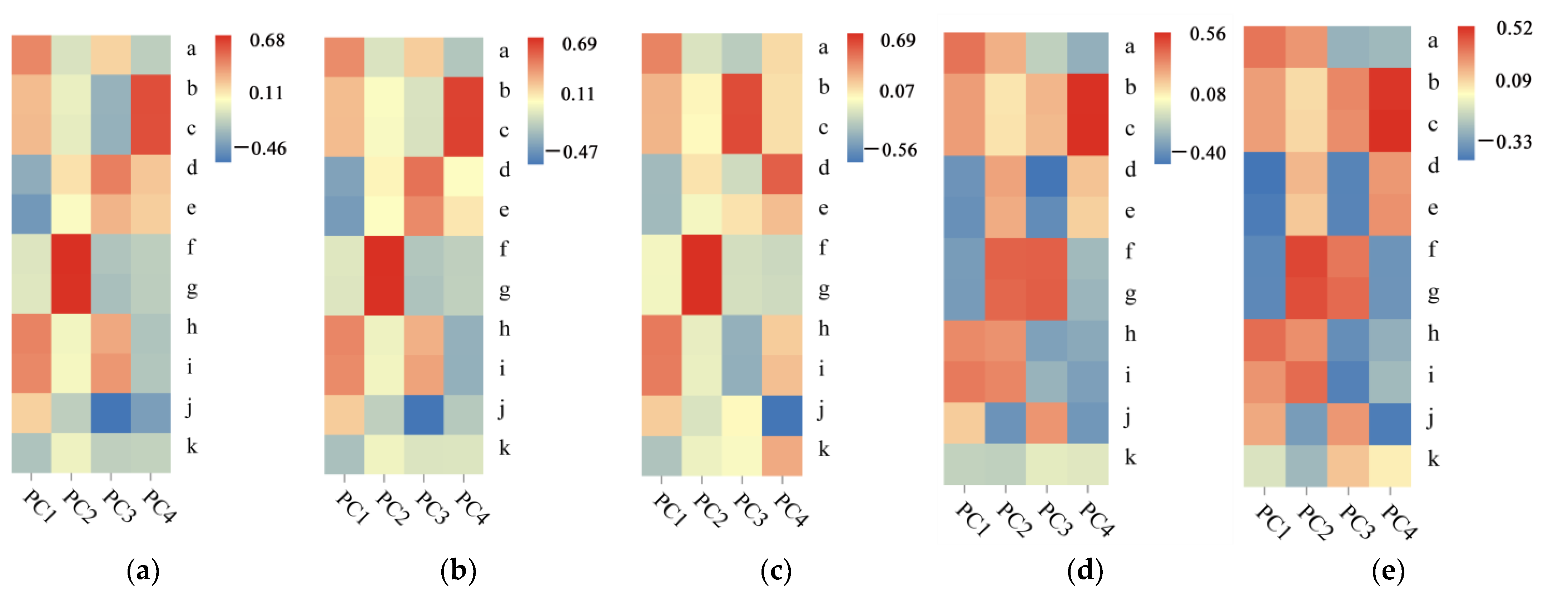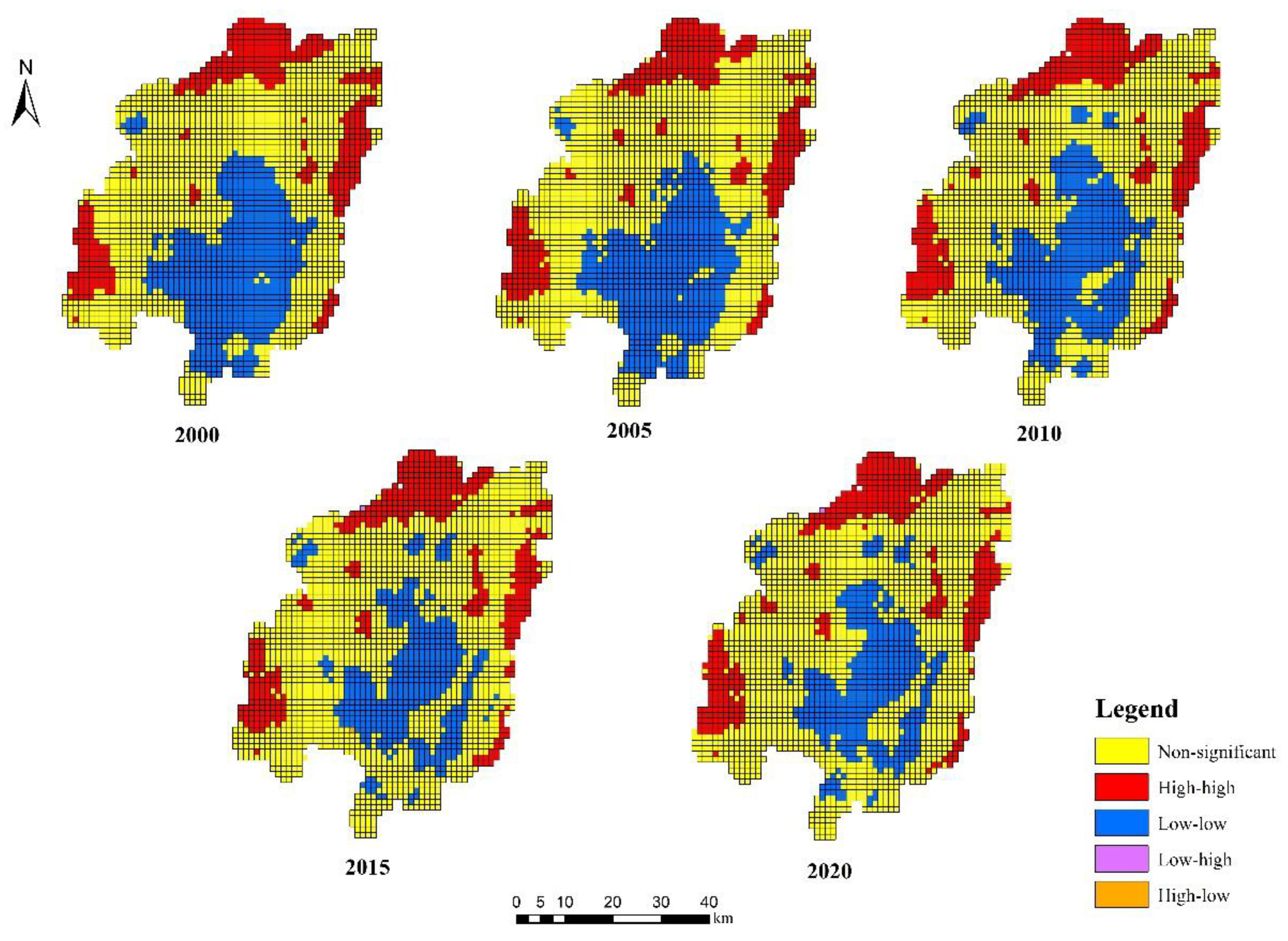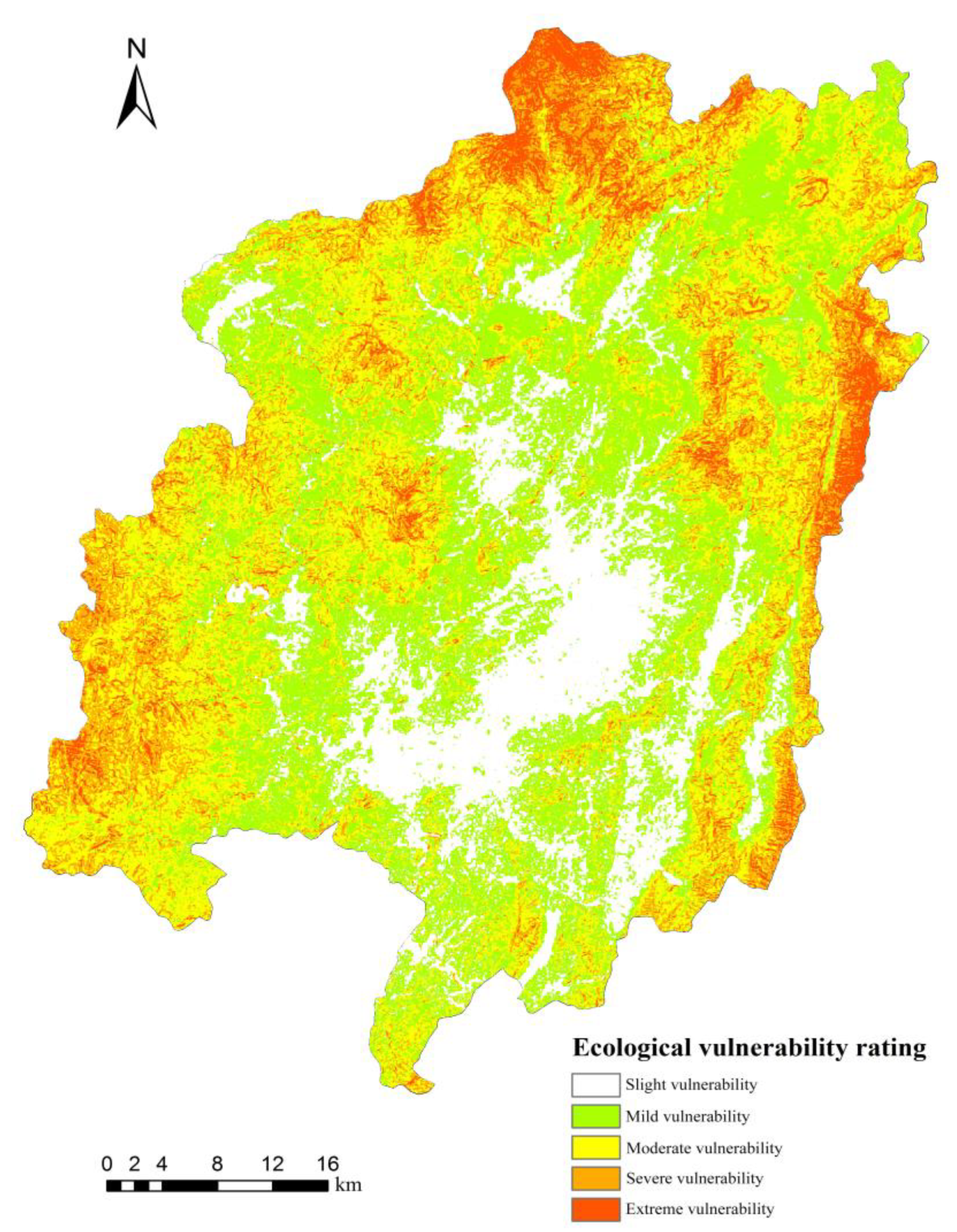Ecological Vulnerability in the Red Soil Erosion Area of Changting under Continuous Ecological Restoration: Spatiotemporal Dynamic Evolution and Prediction
Abstract
:1. Introduction
2. Materials and Methods
2.1. The Study Area
2.2. Data Sources and Preprocessing
2.2.1. Data Sources
2.2.2. Data Preprocessing
2.3. Research Methods
2.3.1. Construction of Assessment Index System
2.3.2. Standardization of Evaluation Index
2.3.3. Ecological Vulnerability Assessment Method [19]
2.3.4. Spatial Autocorrelation Analysis
2.3.5. CA-Markov Model [23]
3. Results
3.1. Temporal and Spatial Variation of Ecological Vulnerability
3.2. Analysis of the Driving Factors of Ecological Vulnerability
3.3. Spatial Agglomeration Characteristics of Ecological Vulnerability
3.3.1. Global Autocorrelation Analysis
3.3.2. Local Autocorrelation Analysis
3.4. Ecological Vulnerability Prediction Results
4. Discussion
5. Conclusions
Author Contributions
Funding
Data Availability Statement
Conflicts of Interest
References
- Beroya-Eitner, M.A. Ecological vulnerability indicators. Ecol. Indic. 2016, 60, 329–334. [Google Scholar] [CrossRef]
- Xu, Z.H.; Gong, C.H.; Liu, J.; Yu, K.Y.; Lai, R.W.; Li, Z.L. Estimation of leaf area index of Pinus massoniana forest by using canopy density and HJ-1 multi-spectral data. J. Plant Resour. Environ. 2013, 22, 29–35. [Google Scholar]
- Wu, X.X.; Gu, Z.J. Contribution Weight of Forest Canopy and Grass Layers to Soil and Water Conservation on Water-Eroded Areas in Southern China. Eurasian Soil Sci. 2020, 53, 1004–1012. [Google Scholar]
- Eakin, H.; Luers, A.L. Assessing the Vulnerability of Social-Environmental Systems. Annu. Rev. Env. Resour. 2006, 31, 365–394. [Google Scholar] [CrossRef] [Green Version]
- Shao, H.Y.; Sun, X.F.; Wang, H.X.; Zhang, X.X.; Xiang, Z.Y.; Tan, R.; Chen, X.Y.; Xian, W.; Qi, J.G. A method to the impact assessment of the returning grazing land to grassland project on regional eco-environmental vulnerability. Environ. Impact Asses. 2016, 56, 155–167. [Google Scholar] [CrossRef]
- Nguyen, A.K.; Liou, Y.A.; Li, M.H.; Tran, T.A. Zoning eco-environmental vulnerability for environmental management and protection. Ecol. Indic. 2016, 69, 100–117. [Google Scholar] [CrossRef]
- Hu, X.J.; Ma, C.M.; Huang, P.; Xu, G. Ecological vulnerability assessment based on AHP-PSR method and analysis of its single parameter sensitivity and spatial autocorrelation for ecological protection—A case of Weifang City, China. Ecol. Indic. 2021, 125, 107464. [Google Scholar] [CrossRef]
- Dossou, J.F.; Li, X.X.; Sadek, M.; Almouctar, M.A.S.; Mostafa, E. Hybrid model for ecological vulnerability assessment in Benin. Sci. Rep. 2021, 11, 1–15. [Google Scholar] [CrossRef] [PubMed]
- Song, G.B.; Li, Z.; Yang, Y.G.; Semakula, H.M.; Zhang, S.S. Assessment of ecological vulnerability and decision-making application for prioritizing roadside ecological restoration: A method combining geographic information system, Delphi survey and Monte Carlo simulation. Ecol. Indic. 2015, 52, 57–65. [Google Scholar] [CrossRef]
- Wu, C.S.; Liu, G.H.; Huang, C.; Liu, Q.S.; Guan, X.D. Ecological Vulnerability Assessment Based on Fuzzy Analytical Method and Analytic Hierarchy Process in Yellow River Delta. Int. J. Environ. Res. Public Health. 2018, 15, 855. [Google Scholar] [CrossRef] [PubMed] [Green Version]
- Luo, J.; Zhang, X.B.; Ding, H.M. Study on the Spatial-temporal Differentiation and Driving Mechanism of Ecological Vulnerability in Zhangye City. IOP Conf. Ser. Mater. Sci. Eng. 2020, 780, 072056. [Google Scholar]
- Li, Y.; Tian, Y.P.; Li, C.K. Comparison Study on Ways of Ecological Vulnerability Assessment—A Case Study in the Hengyang Basin. Procedia Environ. Sci. 2011, 10, 2067–2074. [Google Scholar] [CrossRef] [Green Version]
- Jin, Y.; Meng, J. Assessment and forecast of ecological vulnerability: A review. Chin. J. Ecol. 2011, 30, 2646–2652. [Google Scholar]
- Aretano, R.; Semeraro, T.; Petrosillo, I.; De Marco, A.; Pasimeni, M.R.; Zurlini, G. Mapping ecological vulnerability to fire for effective conservation management of natural protected areas. Ecol. Model. 2015, 295, 163–175. [Google Scholar] [CrossRef]
- Dai, X.; Gao, Y.; He, X.; Liu, T.; Jiang, B.; Shao, H.; Yao, Y. Spatial-temporal pattern evolution and driving force analysis of ecological environment vulnerability in Panzhihua City. Environ. Sci. Pollut. Res. 2021, 28, 1–16. [Google Scholar] [CrossRef] [PubMed]
- Wang, C.C.; Yang, Y.S.; Zhang, Y.Q. Cost-Effective Targeting Soil and Water Conservation: A Case Study of Changting County in Southeast China. Land Degrad. Dev. 2016, 27, 387–394. [Google Scholar] [CrossRef]
- Zhou, Q.W.; Luo, Y.; Zhou, X.; Cai, M.Y.; Zhao, C.W. Response of vegetation to water balance conditions at different time scales across the karst area of southwestern China—A remote sensing approach. Sci. Total Environ. 2018, 645, 460–470. [Google Scholar] [CrossRef]
- Spalevic, V.; Djurovic, N.; Mijovic, S.; Vukelic-Shutosk, M.; Curovic, M. Soil erosion intensity and Runoff on the Djuricka river basin (North of Montenegro). Malays. J. Soil Sci. 2013, 17, 1–17. [Google Scholar]
- Wu, X.L.; Tang, S.Y. Comprehensive evaluation of ecological vulnerability based on the AHP-CV method and SOM model: A case study of Badong County, China. Ecol. Indic. 2022, 137, 108758. [Google Scholar] [CrossRef]
- Zang, Z.; Zou, X.Q.; Zuo, P.; Song, Q.C.; Wang, C.L.; Wang, J.J. Impact of landscape patterns on ecological vulnerability and ecosystem service values: An empirical analysis of Yancheng Nature Reserve in China. Ecol. Indic. 2017, 72, 142–152. [Google Scholar] [CrossRef]
- Liu, Q.; Shi, T.G. Spatiotemporal Differentiation and the Factors of Ecological Vulnerability in the Toutun River Basin Based on Remote Sensing Data. Sustainability 2019, 11, 4160. [Google Scholar] [CrossRef] [Green Version]
- Song, G.B.; Chen, Y.; Tian, M.R.; Lv, S.H.; Zhang, S.S.; Liu, S.L. The Ecological Vulnerability Evaluation in Southwestern Mountain Region of China Based on GIS and AHP Method. Procedia Environ. Sci. 2010, 2, 465–475. [Google Scholar] [CrossRef] [Green Version]
- Faichia, C.; Tong, Z.J.; Zhang, J.Q.; Liu, X.P.; Kazuva, E.; Ullah, K.; Al-Shaibah, B. Using RS Data-Based CA-Markov Model for Dynamic Simulation of Historical and Future LUCC in Vientiane, Laos. Sustainability 2020, 12, 8410. [Google Scholar] [CrossRef]
- Mosier, S.; Córdova, S.C.; Robertson, G.P. Restoring Soil Fertility on Degraded Lands to Meet Food, Fuel, and Climate Security Needs via Perennialization. Front. Sustain. Food Syst. 2021, 5, 706142. [Google Scholar] [CrossRef]
- Qiu, T.; Andrus, R.; Aravena, M.C.; Ascoli, D.; Bergeron, Y.; Berretti, R.; Berveiller, D.; Bogdziewicz, M.; Boivin, T.; Bonal, R. Limits to reproduction and seed size-number trade-offs that shape forest dominance and future recovery. Nat. Commun. 2022, 13, 2381. [Google Scholar] [CrossRef] [PubMed]
- Ledo, A.; Illian, J.B.; Schnitzer, S.A.; Wright, S.J.; Dalling, J.W.; Burslem, D.F.R.P. Lianas and soil nutrients predict fine-scale distribution of aboveground biomass in a tropical moist forest. J. Ecol. 2016, 104, 1819–1828. [Google Scholar] [CrossRef] [Green Version]
- Sun, Y.Q.; Yang, X.; Hao, L.N. Spatial and temporal differentiation and driving mechanism of ecological vulnerability along Sichuan-Tibet railway during 2010-2020 based on SRP model. Bull. Soil Water Conserv. 2021, 41, 201–208. [Google Scholar]
- Chen, S.F.; Zha, X.; Bai, Y.H.; Wang, L.Y. Evaluation of soil erosion vulnerability on the basis of exposure, sensitivity, and adaptive capacity: A case study in the Zhuxi watershed, Changting, Fujian Province, Southern China. Catena 2019, 177, 57–69. [Google Scholar] [CrossRef]
- Zhang, X.Y.; Liu, K.; Wang, S.D.; Wu, T.X.; Li, X.K.; Wang, J.N.; Wang, D.C.; Zhu, H.T.; Tan, C.; Ji, Y.H. Spatiotemporal evolution of ecological vulnerability in the Yellow River Basin under ecological restoration initiatives. Ecol. Indic. 2022, 135, 108586. [Google Scholar] [CrossRef]
- Maria Berrouet, L.; Machado, J.; Villegas-Palacio, C. Vulnerability of socio—Ecological systems: A conceptual Framework. Ecol. Indic. 2018, 84, 632–647. [Google Scholar] [CrossRef]
- Bernhardt, J.R.; Leslie, H.M. Resilience to Climate Change in Coastal Marine Ecosystems. Ann. Rev. Mar. 2013, 5, 371–392. [Google Scholar] [CrossRef] [PubMed] [Green Version]
- Okey, T.A.; Agbayani, S.; Alidina, H.M. Mapping ecological vulnerability to recent climate change in Canada’s Pacific marine ecosystems. Ocean Coast Manag. 2015, 106, 35–48. [Google Scholar] [CrossRef]
- Zhang, X.Q.; Wang, L.K.; Fu, X.S.; Li, H.; Xu, C.D. Ecological vulnerability assessment based on PSSR in Yellow River Delta. J. Clean Prod. 2017, 167, 1106–1111. [Google Scholar] [CrossRef]
- Kan, A.K.; Li, G.Q.; Yang, X.; Zeng, Y.L.; Tesren, L.; He, J. Ecological vulnerability analysis of Tibetan towns with tourism-based economy: A case study of the Bayi District. J. Mt. Sci. 2018, 15, 1101–1114. [Google Scholar] [CrossRef]
- Lin, C.; Zhou, S.L.; Wu, S.H.; Liao, F.Q. Relationships between Intensity Gradation and Evolution of Soil Erosion: A Case Study of Changting in Fujian Province, China. Pedosphere 2012, 22, 243–253. [Google Scholar] [CrossRef]
- Qiao, H. Review of comprehensive evaluation of principal component and its applicability. J. Tianjin Univ. Commer. 2015, 35, 9–14. [Google Scholar]
- Xue, L.Q.; Wang, J.; Zhang, L.C.; Wei, G.H.; Zhu, B.L. Spatiotemporal analysis of ecological vulnerability and management in the Tarim River Basin, China. Sci. Total Environ. 2019, 649, 876–888. [Google Scholar] [CrossRef]
- Gupta, A.K.; Negi, M.; Nandy, S.; Alatalo, J.M.; Singh, V.; Pandey, R. Assessing the vulnerability of socio-environmental systems to climate change along an altitude gradient in the Indian Himalayas. Ecol. Indic. 2019, 106, 105512.1–105512.11. [Google Scholar] [CrossRef]
- Yao, K.; Zhang, C.J.; He, L.; Li, Y.X.; Li, X.J. Dynamic evaluation and prediction of ecological environment vulnerability in the middle-upper reaches of the Yalong River. Remote Sens. Nat. Resour. 2020, 32, 199–208. [Google Scholar]






| Target Layer | Criterion Layer | Factor Layer | Index Layer | Index Properties |
|---|---|---|---|---|
| Ecological vulnerability | Ecological sensitivity | Topographic factors | Elevation | Positive |
| Slope | Positive | |||
| Relief degree of land surface | Positive | |||
| Meteorological factors | Annual average temperature | Negative | ||
| Annual average precipitation | Positive | |||
| Surface factors | Soil erosion intensity | Qualitative | ||
| Land use type | Qualitative | |||
| Ecological resilience | Vegetation factor | NDVI | Negative | |
| Landscape structure | Landscape diversity | Negative | ||
| Ecological pressure | Socioeconomic factors | Population density | Positive | |
| GDP density | Positive |
| Criterion Layer | Factor Layer | Index Layer |
|---|---|---|
| Ecological vulnerability rating | Standardized value of ecological vulnerability index | Ecological characteristics |
| Slight vulnerability (I) | Si ≤ 1.827 | The ecosystem structure is stable, function is perfect, pressure on the ecological environment is small, ecological resilience and anti-interference abilities are strong, and there is no ecological anomaly. |
| Mild vulnerability (II) | 1.827 < Si ≤ 2.800 | The ecosystem structure is relatively stable, function is relatively perfect, ecological environment is under less pressure, ecological resilience and anti-interference abilities are relatively strong, ecological environment has potential abnormalities, and ecological vulnerability is relatively low. |
| Moderate vulnerability (III) | 2.800 < Si ≤ 3.773 | The ecosystem structure is relatively unstable, and self-resilience and anti-interference abilities are relatively weak; although the ecological pressure is at an acceptable level, it has reached a critical value, and a small number of ecological anomalies have occurred. |
| Severe vulnerability (IV) | 3.773 < Si ≤ 4.973 | The ecosystem structure is unstable, ecological function is degraded to a certain extent, sensitivity to external interference is strong, self-recovery and anti-interference abilities are relatively poor, and ecological environment problems are relatively serious. |
| Extreme vulnerability (V) | Si > 4.973 | The ecosystem structure is extremely unstable, ecological function is seriously degraded, sensitivity to external interference is strong, self-recovery and anti-interference abilities are poor, and the ecological environment has serious ecological anomalies. |
| Years | Proportion of Slight Vulnerability (%) | Proportion of Mild Vulnerability (%) | Proportion of Moderate Vulnerability (%) | Proportion of Severe Vulnerability (%) | Proportion of Extreme Vulnerability (%) | EVSI |
|---|---|---|---|---|---|---|
| 2000 | 19.17 | 26.46 | 24.99 | 19.94 | 9.39 | 2.74 |
| 2005 | 19.00 | 28.73 | 26.93 | 17.89 | 7.45 | 2.66 |
| 2010 | 26.47 | 31.65 | 24.55 | 13.18 | 4.16 | 2.37 |
| 2015 | 18.29 | 30.55 | 29.83 | 16.87 | 4.45 | 2.59 |
| 2020 | 21.49 | 31.77 | 27.90 | 15.07 | 3.78 | 2.48 |
Publisher’s Note: MDPI stays neutral with regard to jurisdictional claims in published maps and institutional affiliations. |
© 2022 by the authors. Licensee MDPI, Basel, Switzerland. This article is an open access article distributed under the terms and conditions of the Creative Commons Attribution (CC BY) license (https://creativecommons.org/licenses/by/4.0/).
Share and Cite
Wu, X.; Zhu, C.; Yu, J.; Zhai, L.; Zhang, H.; Yang, K.; Hou, X. Ecological Vulnerability in the Red Soil Erosion Area of Changting under Continuous Ecological Restoration: Spatiotemporal Dynamic Evolution and Prediction. Forests 2022, 13, 2136. https://doi.org/10.3390/f13122136
Wu X, Zhu C, Yu J, Zhai L, Zhang H, Yang K, Hou X. Ecological Vulnerability in the Red Soil Erosion Area of Changting under Continuous Ecological Restoration: Spatiotemporal Dynamic Evolution and Prediction. Forests. 2022; 13(12):2136. https://doi.org/10.3390/f13122136
Chicago/Turabian StyleWu, Xinyi, Chenlu Zhu, Junbao Yu, Lin Zhai, Houxi Zhang, Kaijie Yang, and Xiaolong Hou. 2022. "Ecological Vulnerability in the Red Soil Erosion Area of Changting under Continuous Ecological Restoration: Spatiotemporal Dynamic Evolution and Prediction" Forests 13, no. 12: 2136. https://doi.org/10.3390/f13122136





